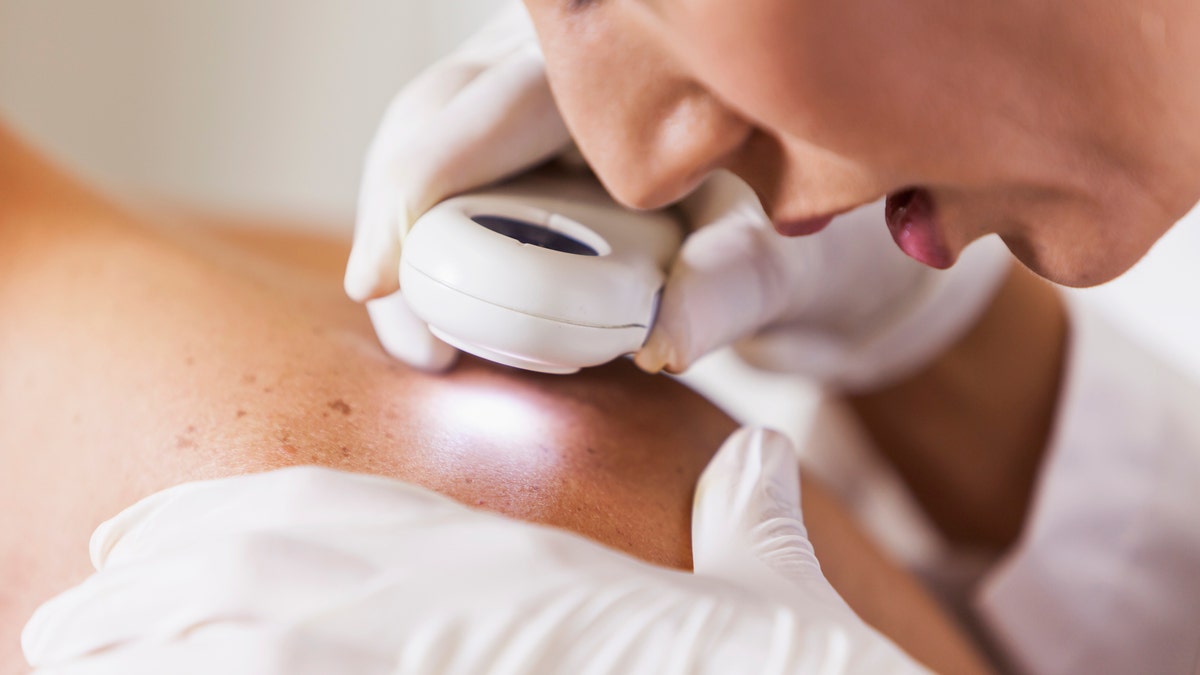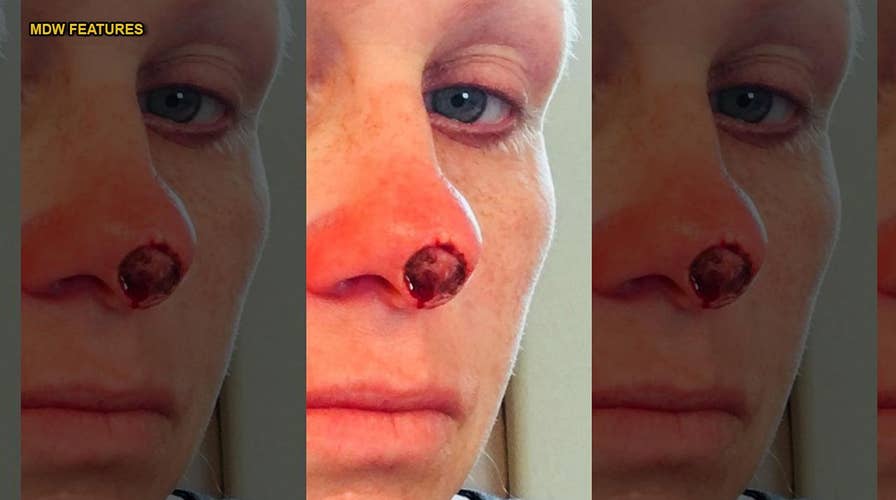Woman who tanned up to six times a week left with hole in face after skin cancer diagnosis
An Oklahoma woman who tanned up to six times a week developed skin cancer so serious that she had to have Mohs surgery, a procedure that left her with a gaping hole in her nose and a flap of skin sticking out her forehead.
Are you at risk for developing skin cancer, what’s considered to be the most common cancer in the U.S.?
An estimated one in five Americans will develop the condition during their lifetime, according to the American Academy of Dermatology. But what is skin cancer? And why are some people more prone to developing it than others?
KENTUCKY MOM DIAGNOSED WITH SKIN CANCER, LEFT WITH MASSIVE SCAR AFTER USING TANNING BEDS FOR YEARS
“If you have skin, you can get skin cancer,” Dr. Saya Obayan, a board-certified dermatologist practicing in Austin, Texas, and a spokesperson for The Skin Cancer Foundation, told Fox News.
Read on for a look at skin cancer and what to do if you’re concerned you may have it.
Fox News: What is skin cancer?
Dr. Saya Obayan: Skin cancer is the uncontrolled growth of abnormal skin cells. It occurs when unrepaired DNA damage to skin cells triggers mutations, or genetic defects, that cause the cells to multiply rapidly and form malignant tumors. This damage is often caused by ultraviolet (UV) radiation from the sun or tanning beds.
Fox News: Are there different types of skin cancer? Are there some types that are more severe than others?
Dr. Saya Obayan: The three most common types of skin cancer are basal cell carcinoma, squamous cell carcinoma, and melanoma.
Basal cell carcinoma (BCC) is the most common form of skin cancer. These cancers form within the skin’s basal cells, which line the deepest part of the epidermis – the outermost layer of the skin. They sometimes look like open sores, red patches, pink growths, shiny bumps, or scars. Almost all BCCs occur on parts of the body excessively exposed to the sun, such as the face, ears, neck, scalp, shoulders, and back. Because BCCs grow slowly, most are curable and cause minimal damage when caught early.
'BACHELORETTE' STAR ALI FEDOTOWSKY-MANNO REVEALS SKIN CANCER DIAGNOSIS: 'I CAUGHT IT EARLY'
Squamous cell carcinoma (SCC) is the second most common kind of skin cancer, and form in the squamous cells of the epidermis. SCC is mainly caused by cumulative UV exposure over the course of a lifetime and is typically found in areas frequently exposed to the sun (the rim of the ear, lower lip, face, balding scalp, neck, hands, arms, and legs). SCCs may look like scaly red patches, open sores, warts or elevated growths with a central depression; they may crust or bleed. Most SCCs can be easily and successfully treated, but if allowed to grow, they can become disfiguring and even deadly.
Out of the more common forms of skin cancer, melanoma is the most dangerous. Melanoma develops from melanocytes, the skin cells that produce melanin pigment, which gives skin its color. It is often triggered by intense, intermittent UV exposure — the kind that can come from indoor tanning or excessive sunbathing. Melanomas often resemble moles, and can even develop from moles. Many of them are black or brown, but they can also be skin-colored, pink, red, purple, blue or white. Melanoma is usually curable if detected and treated early, but can become more difficult to treat and can be deadly if it spreads deeper into the skin or other parts of the body.

Skin cancer is the most common cancer in the U.S. (iStock)
Merkel Cell Carcinoma (MCC) is a much rarer form of skin cancer, but it can be extremely aggressive and has a high chance of spreading and recurring. MCCs begin in Markel cells at the base of the epidermis. They usually appear as firm, painless lesions or nodules on a sun-exposed area (sometimes on the head and neck, and frequently on eyelids).
Fox News: Why do some people develop it? Who is most at risk?
Dr. Saya Obayan: First of all, if you have skin, you can get skin cancer. But there are several factors that can increase your risk of developing the disease. These include a history of indoor tanning or sunburns, your skin type (the lighter your complexion, the more at risk you are), and genetics.
A history of tanning bed use, even just once, can increase your risk for skin cancer. In fact, people who first use a tanning bed before age 35 increase their risk for melanoma by 75 percent. A history of sunburns also increases your risk — on average, a person’s risk for melanoma doubles if they have had more than five sunburns. But don’t assume you’re safe just because you don’t burn. A tan is the skin’s attempt to prevent further injury by increasing skin pigment, which means you’ve already sustained skin cell damage.
People with very fair skin are extremely susceptible to skin damage from UV radiation, and therefore to developing skin cancer. People of color are less susceptible to UV damage due to the greater amounts of melanin darker skin produces, but they are still at risk. When they do develop skin cancer, it tends to be found at a later, more deadly stage.
WOMAN'S 'CHICKENPOX SCAR' TURNS INTO SKIN CANCER DECADES AFTER ILLNESS

Wearing sunscreen can help prevent skin cancer. (iStock)
Lastly, genetics plays a role in melanoma — about one in every 10 patients diagnosed with the disease has a family member with a history of melanoma. If your mother, father or siblings had melanoma, you’re in a melanoma-prone family.
Fox News: Is skin cancer difficult to treat?
Dr. Saya Obayan: The earlier a skin cancer is diagnosed, the easier it is to treat. The larger and deeper a tumor grows, the more dangerous and potentially disfiguring it may become, and the more extensive the treatment must be. Most skin cancers can be treated successfully when detected at an early stage. When left untreated, skin cancer cells can spread, grow deep into the skin, and be more likely to reoccur.
A dermatologist will weigh several factors before determining the best course of treatment, including the size, location, and of course, type of the tumor. A patient’s age and medical history will also be considered. Based on these factors, a variety of treatments can be used: surgery, laser, and light-based treatments, radiation therapy, topical medications, and oral or injected medications. In more advanced cases where cancer has spread beyond the tumor site, chemotherapy may also be used.
Fox News: How can you protect yourself from developing skin cancer?
Dr. Saya Obayan: Prevention is key when it comes to skin cancer. The Skin Cancer Foundation has always recommended a complete sun protection strategy that includes seeking shade, covering up with clothing, hats, and sunglasses and wearing sunscreen every day.
Clothing is the most effective form of sun protection — it’s our first line of defense against the sun’s harmful rays. It’s also less complicated than sunscreen since you don’t need to worry about adequate application and reapplication. Wear hats with a brim that extends three inches or more all the way around to shade your face, neck, and ears. Look for sunglasses that cover the eyelids and as much of the surrounding area as possible.
Use a broad-spectrum sunscreen with an SPF of at least 15 or higher every day. For extended outdoor activity, use a water-resistant, broad-spectrum sunscreen with an SPF of 30 or higher. You should apply two tablespoons (equivalent to about a shot glass full) of sunscreen to the entire body, and a nickel-sized dollop to the face. Reapply every two hours or immediately after swimming or sweating.
Lastly, seek the shade when you can, especially between 10 AM and 4 PM when the sun’s rays are strongest.
Fox News: When should you see a doctor?
MOM TOLD CANCER WOULD 'EAT AWAY AT YOUR NOSE' WITHOUT URGENT TREATMENT
Dr. Saya Obayan: Early detection is critical since skin cancers found and removed early are highly treatable. If it goes undetected, however, skin cancer can become disfiguring and even deadly. The Skin Cancer Foundation recommends everyone see a dermatologist annually for a professional skin exam. In addition to this, you should be checking your skin from head-to-toe carefully once a month.
Skin cancers can have an incredibly varied appearance, but the bottom line is if you see something new, changing or unusual, get it checked by a dermatologist as soon as possible. This includes any new moles, moles that change size or shape, a growth that won’t stop itching or bleeding, or an open sore that won’t heal within three weeks. Skin cancer can also resemble something as nondescript as a pimple or crusty red patch, so it’s important to check your skin often and take note of any changes.





















